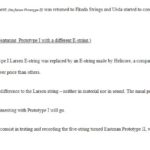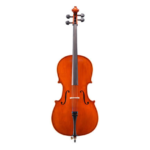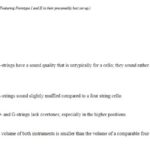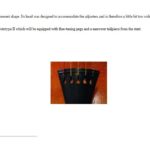After the project was approved on April 4th the team started discussing the schedule of proceeding.
It was decided to construct at least one prototype of a five string cello in order to learn about basic sound- and handling properties.
Construction of PROTOTYPE I was begun on April 5th and the instrument was ready for first testing on April 15th.
PROTOTYPE I
CONSTRUCTION
Construction started on April 5th, converting an existent, low-priced four string body to a five string cello. The instrument in question is a 4/4 (Full size; 750mm body length; string distance from nut to bridge: 680 mm.) cello, presumably Check-made around 40 years ago. Equipped strings are: C-string: Spirocore (Tungsten18); G-string: Larsen (Tungsten); D, A- and E-string19: Larsen. A special tail piece was manufactured by Ueda that can accommodate five strings and adjusters. (Pictures 6 and 12.)
The fingerboard was removed and replaced by a modified bass fingerboard. As seen, it is slightly protruding over the original neck. (Picture 7.)
A new bridge was constructed, featuring a broader head in order to accommodate five strings in roughly the same distance from each other than on a four string bridge. The feet have the same spacing and placing as a bridge on a four string cello. (Picture 8.)
An additional hole was drilled into the upper part of the peg box and a fifth peg was inserted (Picture 9. Picture 10 shows the process of drilling a hole into the peg box. Picture 11 shows the filled holes of a 4-stringed cello’s peg box. This procedure is necessary because the additional fifth string calls for a repositioning of the peg holes.)
No internal changes were performed.
| Picture 6 | Picture 7 | Picture 8 | Picture 9 |
 |
 |
 |
 |
| Picture 10 | Picture 11 |
 |
 |
TEST RESULTS [1]
SOUND QUALITY
The first sound-test results were actually rather disappointing.
– The E-string, when used as an open string and in the low positions, has a ’nasal’ quality, rather different from the other strings’ sound quality, somehow resembling a treble viol’s sound. (It is a surprising fact that a violin’s E-string is even thinner than a cello’s but has no nasal sound at all.)
However, from the 4th position upwards the E-string produces a clearer and louder sound than the A-string does for the same notes.
– The A-string has a more muted quality than a comparable four string cello’s A-string has.
– Both D- and G-string respond not very well above the third position.
– C-string shows no major changes compared to a four string cello’s C-string.
– There is a quite strong ‘wolf’ on all F-s.20 (See Glossary.)
Overall there is a certain loss of volume noticeable when the Prototype I is compared to a four string cello of similar quality level. How far this was inherent in the instrument or caused by the conversion is difficult to tell. In order to clear up that question the sound properties of Prototype II will be extensively tested before the conversion.
PLAYABILITY
– String changes are almost the same as on a four string cello; only E- and A-string are a bit too close when playing in high positions on the A-string. (Could be resolved by a steeper curving of bridge and fingerboard.)
– After overcoming initial difficulties of finding the right notes on the ‘new’ string, playing the 6th Bach suite, the Arpeggione sonata and other pieces with difficult high passages could become a pleasure.
18 Tungsten is a strong (and quite expensive) metal that allows the production of strings thinner than the usually used steel versions. Thinner strings reduce pressure on the instrument’s body which results in easier response and bigger sound volume.
19 Three main string manufactures (Larsen, Jargar, Helicore) some years ago started manufacturing and selling cello E-strings. They are rather expensive but are easily available in Europe and America. In Japanese dealers’ string catalogues cello E-strings still do not appear.
20 A wolf is a disturbance of the vibration of a string on a certain pitch, caused by acoustical interferences between the vibrations of strings and the instrument’s body. On a four-string cello it is usually most strongly present within the G-string’s forth position, affecting pitches from E to G.





